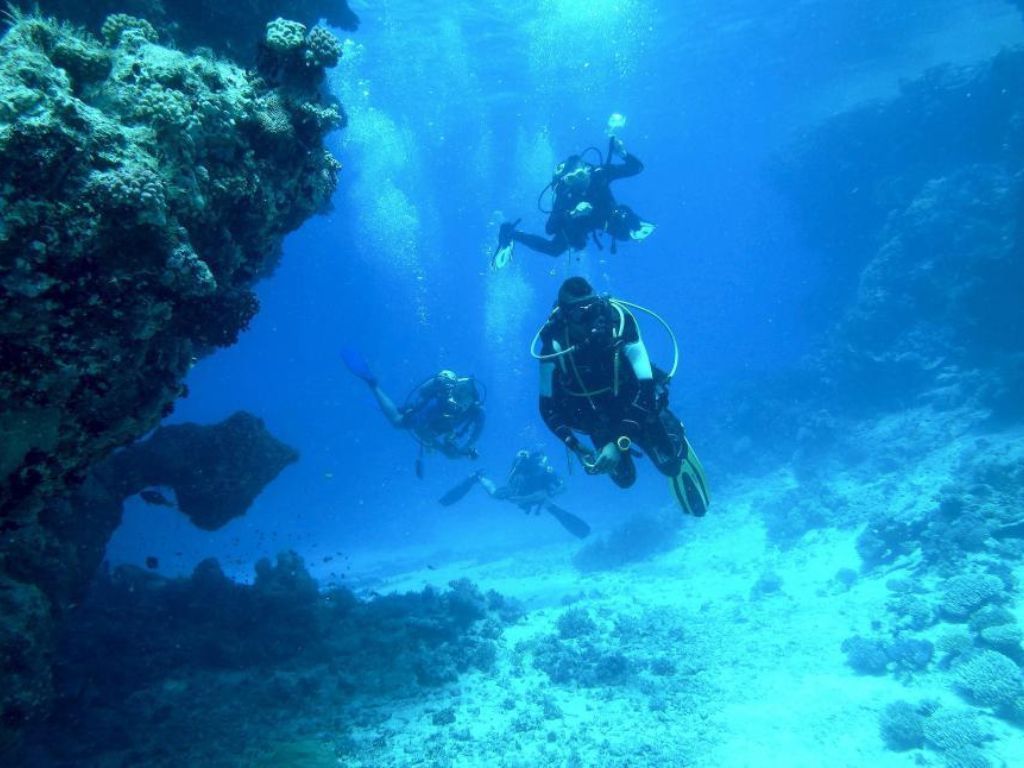Are you planning on scuba diving in Lanzarote? In this guide we’ll tell you everything you need to know to make this happen! We’ll explore the best sites and areas to dive in, talk about PADI certifications and how to get one, and we’ll reveal one of the coolest diving spots you could find on the island. Read ‘till the end!
Tabla de Contenidos
Diving in Lanzarote is a memorable experience
Under the surface, Lanzarote’s seas are a parade of volcanic marvels. The ocean floor is sculpted with lava flows and formations, offering a unique backdrop for marine life. This underwater terrain, featuring caves, tunnels, and arches, makes for some of the most distinctive diving and snorkeling experiences in the world.
The clarity of the waters around Lanzarote enhances the underwater experience, offering excellent visibility for exploring this vibrant marine ecosystem. Here, you’ll encounter a diverse array of sea creatures, each adding to the vivid tapestry of life beneath the waves.
In Lanzarote, underwater exploration is not just about the thrill; it’s about immersing yourself in a part of the island that few get to see. It’s a blend of adventure and the rare opportunity to witness how nature intricately weaves land and sea into breathtaking landscapes. Whether you’re a seasoned diver or a casual snorkeler, the waters of Lanzarote invite you to discover their hidden volcanic wonders.
Where is the best place to dive in Lanzarote?
Whether you’re drawn to the predator-prey interactions, the peaceful and artistic atmosphere of an underwater museum, or the thrill of exploring wrecks, Lanzarote can offer you an unforgettable diving adventure.
Playa Chica – A World of Underwater Diversity
Nestled in Puerto Del Carmen, Playa Chica is not just a dive site; it’s an underwater universe teeming with life. Here, divers of all levels can enjoy a variety of experiences. The shallow waters are alive with ornate wrasse, damselfish, and goatfish, while deeper areas are hunting grounds for barracuda, yellow fin tuna, and jacks. Rays, Angel Sharks, and even Giant Groupers – some larger than humans – are common sights. Night dives at Playa Chica reveal an active nocturnal world, with crabs, shrimps, and sea hares. The site’s diverse terrain includes The Blue Hole, The Cathedral, The Shrimp Cave, and The Eye, each offering unique underwater landscapes and marine life.
The Blue Hole – An Ethereal Experience
The Blue Hole, a part of Playa Chica, is renowned for its mesmerizing swim-through. Filled with marine life like sponges, clams, arrow crabs, and nudibranchs, it presents an otherworldly experience. As you glide through and look back, the Blue Hole’s stunning visual spectacle is unforgettable. This site caters to various levels of divers and is considered by many as the pinnacle of Lanzarote’s diving experiences.


Grouper Run – An Underwater Spectacle
Another highlight at Playa Chica, Grouper Run, offers a unique display of marine behavior. Here, divers can watch Groupers waiting to feast on the remnants left by hunting jacks, tuna, and barracudas. The site’s dynamic nature, with predator and prey interactions, makes it a thrilling spot for those seeking an action-packed dive.
Waikiki and Playa Grande – Drift and Wall Diving Adventures
For enthusiasts of drift and wall diving, Waikiki and Playa Grande offer perfect conditions. These sites feature impressive wall dives rich in micro-life. When currents align, they become exhilarating drift dives, providing opportunities to see rays, sharks, and other pelagic species in the open waters.
Wreck Diving Extravaganza
Lanzarote’s underwater allure includes fascinating wreck dives. The Harbour Wrecks, with six sunken fishing boats, offer a journey through underwater history, starting from depths of 40 meters. The Tuna Wrecks, home to three tuna fishing boats, are now ironically inhabited by tuna, creating an intriguing ecosystem. Additionally, the capital city, Arrecife, hosts two more wrecks: the Rabat and Telemon (or Temple Hall), each with its own story and marine inhabitants.
Atlantic Museum – Where Art Meets Ocean
At Playa Blanca, the Museo Atlántico awaits, an underwater museum crafted by artist Jason De Carnes Taylor. Opened in 2016, this site features sculptures modeled on Lanzarote locals, providing an artistic spectacle that harmoniously coexists with marine life. This dive is an unforgettable blend of human creativity and natural beauty.


Guided Tours for Diving and Snorkeling
Diving and snorkeling tours in Lanzarote are tailored to showcase the best of the island’s marine life and underwater terrains. These guided tours, led by experienced and knowledgeable instructors, provide you with an opportunity to safely explore the vibrant marine ecosystems.
- For Beginners: There are numerous beginner-friendly options both in Puerto del Carmen and Costa Teguise. These include introductory dives, where basics are taught in shallow waters, and guided snorkeling tours, which allow novices to comfortably explore the underwater world with minimal equipment and training.
- Night Dives: For a more unique experience, night dives are offered by several dive centers. These dives reveal the nocturnal activities of marine life, offering a different perspective of the underwater world. Night dives are typically recommended for more experienced divers.
- Specific Site Tours: Tours often target specific popular sites, such as the Museo Atlántico or the Blue Hole, providing a focused experience on the unique features of these locations.
Diving Certification and Training Opportunities in Lanzarote
Lanzarote is also an excellent place to gain or advance your diving qualifications. Many scuba diving centers on the island offer certification courses from recognized organizations like PADI (Professional Association of Diving Instructors) both in Costa Teguise and Puerto del Carmen, and also SSI (Scuba Schools International).
- Open Water Diving Courses: For beginners, the Open Water Diver course is the first step into scuba diving certification. It combines classroom learning, confined water dives, and open water dives to ensure a comprehensive understanding and skill set.
- Advanced and Specialty Courses: For those looking to enhance their skills, Advanced Open Water Diver and specialty courses like deep diving, underwater navigation, or wreck diving are available.
- Technical Diving and Professional Level Training: For serious diving enthusiasts, technical diving courses and professional level certifications like Divemaster or Instructor Development Courses (IDC) are also offered in Lanzarote.

There's A Whole World Under the Sea
The marine ecosystem around Lanzarote is rich and varied, providing habitats for numerous species. For example, reefs and rocky outcrops are bustling with life, including colorful fish such as parrotfish, damselfish, and ornate wrasses. Invertebrates like sea urchins, starfish, and anemones add to the diversity.
Larger species such as barracudas, groupers, and yellowfin tuna are often spotted hunting in these waters. These predators play a crucial role in maintaining the ecological balance.
Octopuses and cuttlefish, known for their incredible camouflage abilities, are also a common sight. Night dives reveal active crustaceans like crabs and shrimps.
The sandy bottoms and deeper waters are home to various species of rays and occasionally sharks, including the elusive angel shark, a species of interest due to its conservation status. If you’d like to experience the thrill of diving with sharks but open waters are not your thing, you can book a dive in the safe environment of Costa Teguise Aquarium — where you can swim with one of the most fascinating creatures found in the ocean and have an exhilarating adrenaline rush.
Depending on the time of year, you might also encounter migratory species such as dolphins and whales passing through the waters of Lanzarote.
Eco-Responsibility While Exploring Underwater
The exploration of this vibrant underwater world comes with a responsibility to protect it. Eco-friendly practices are crucial for the sustainability of marine ecosystems. Most of all, make sure to:
Respect Marine Life: It’s important to observe marine life without disturbing their natural behaviors. This means maintaining a safe distance and not touching, feeding, or chasing any marine creatures.
Commit to Sustainable Practices: Eco-friendly diving includes being mindful of one’s buoyancy to avoid damaging the reefs, using eco-friendly sunscreen to prevent chemical pollution, and ensuring no litter is left behind.


Getting Ready for Your Scuba Diving Adventure in Lanzarote
Planning an underwater excursion in Lanzarote, whether it’s scuba diving or snorkeling, requires careful preparation to ensure both safety and enjoyment. When it comes to selecting your gear, the focus should be on comfort and suitability to the conditions.
The water temperature in Lanzarote varies across seasons; a shorty wetsuit or a 3mm suit often suffices during warmer months, while cooler times might call for a thicker 5mm or 7mm suit. Your mask and fins are crucial for a clear view and efficient movement underwater: make sure your mask fits well to avoid leaks, and choose fins that suit the type of diving you’ll be doing – longer fins are better for open water, and shorter ones are ideal for navigating reefs.
Snorkelers should look for a high-quality snorkel with a comfortable mouthpiece, and a purge valve can make clearing water easier. Scuba divers need to ensure their BCD fits well for effective buoyancy control and that their regulators are in top condition. Renting from reputable dive centers in Lanzarote is a good way to guarantee well-maintained equipment. Don’t forget other accessories like dive computers, underwater cameras, and dive lights, especially if you’re planning on night dives or exploring caves.
The best time for diving and snorkeling in Lanzarote depends on what you’re looking to experience. The summer months, from June to September, offer warmer waters and generally calmer sea conditions, making it an ideal time for beginners or those who prefer thinner wetsuits. The winter months, from November to March, though cooler, bring some unique marine life closer to shore, like angel sharks, and are often marked by excellent visibility. Spring and autumn provide a middle ground with moderate water temperatures and diverse marine life.

Conclusion
Lanzarote’s underwater world is not just a destination, but a journey into the heart of nature’s marvels. Each dive is an opportunity to connect with the ocean in a way that is respectful, enlightening, and deeply rewarding.
Are you ready to dive into the mesmerizing underwater world of Lanzarote? Don’t just dream about the underwater wonders of Lanzarote, dive right into them.
Book your stay with Lanzarote Vacation Homes today and turn those dreams into reality! Immerse yourself in comfort, convenience, and the captivating beauty of Lanzarote’s underwater world.



